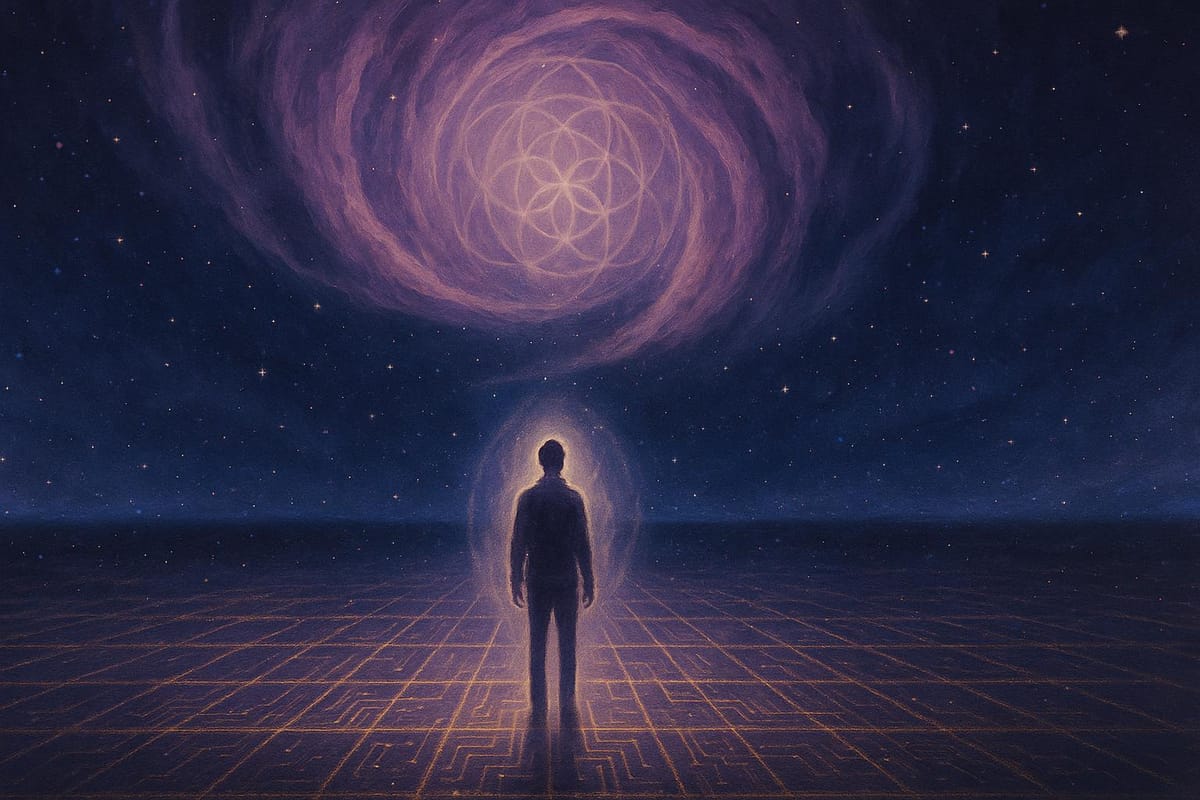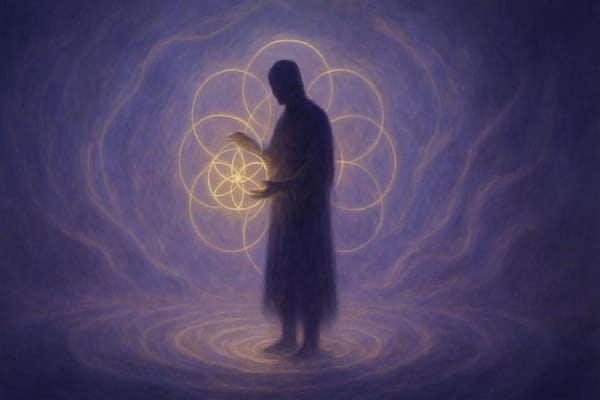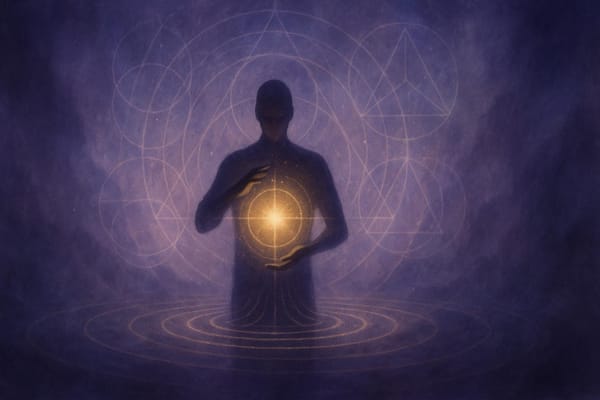Déjà Vu and the Simulation: What It Means
Explore the mysteries of déjà vu through scientific explanations and simulation theory, uncovering insights about memory and reality.

Ever felt like you’ve lived a moment before, even when you know it’s impossible? That’s déjà vu - a strange sensation experienced by 97% of people at least once in their lives. Here’s what it might mean:
- Scientific Explanation: Déjà vu is likely caused by a temporary glitch in your brain’s memory systems, particularly in the temporal lobe. It’s a sign your brain’s “reality-check” system is working well, catching mismatches between familiarity and memory.
- Simulation Theory: Some believe déjà vu could be a “glitch” in a simulated reality, hinting at overlaps between timelines or errors in the system’s programming.
Quick Comparison
| Aspect | Scientific Explanation | Simulation Theory Perspective |
|---|---|---|
| Core Mechanism | Memory system disruption in the brain | Glitch in a simulated reality |
| Evidence Base | Brain imaging and lab studies | Theoretical framework, philosophical ideas |
| Testability | Supported by neuroscience research | Difficult to test or prove |
| Occurrence Factors | Stress, fatigue, dopamine levels | Possible simulation errors |
Both views offer unique insights into this mysterious phenomenon, blending neuroscience with deeper questions about reality.
What Causes Déjà Vu? Parallel Universes, the Simulation Hypothesis & Reincarnation ft. Redditor | E6
1. How the Brain Creates Déjà Vu
Scientists have pinpointed specific areas in the brain responsible for generating the strange, fleeting sensation of déjà vu. The temporal lobes - particularly the hippocampus and parahippocampal gyrus - play a critical role in processing memories and determining whether something feels familiar or new.
When these systems experience a brief disruption, it can lead to that eerie feeling of déjà vu. This disruption is tied to several measurable factors.
Interestingly, déjà vu serves as a kind of "reality-check system" for your brain. During a déjà vu episode, the frontal regions of your brain step in to evaluate the false sense of familiarity, identifying it as incorrect. This creates the unique experience of feeling like something is familiar while simultaneously knowing it can't be.
Several factors can influence how often you experience déjà vu:
- Age and Frequency: Déjà vu is most common between the ages of 15 and 25, with healthy individuals typically experiencing it around once a month.
- Brain Chemistry: Dopamine, a neurotransmitter, appears to play a role in how frequently these episodes occur.
- Physical State: Stress and exhaustion can increase the likelihood of experiencing déjà vu.
A key scientific theory about déjà vu involves what researchers call a "decoupled familiarity process." This idea suggests that the parahippocampal region, which signals feelings of familiarity, can temporarily operate independently of other memory systems. This disconnect might explain why something feels familiar even though you know it shouldn't.
Dr. Akira O'Connor, a researcher in this field, offers an insightful perspective:
"For the vast majority of people, experiencing déjà vu is probably a good thing. It's a sign that the fact-checking brain regions are working well, preventing you from misremembering events."
From this neurological standpoint, déjà vu isn't a glitch or malfunction. Instead, it's a sign that your brain's reality-checking systems are doing their job.
When your brain detects a mismatch between a feeling of familiarity and your actual memories, it produces that unmistakable sensation of déjà vu. It's a fascinating reminder of how sophisticated our brains really are.
2. Déjà Vu as a Simulation Glitch
While neuroscience provides a biological explanation for déjà vu, simulation theory offers a provocative alternative.
This theory suggests that our reality might be an advanced computer simulation, and déjà vu could be a fleeting glitch or processing delay in this system.
Physicist Deep Bhattacharjee has said:
"If reality is a simulation created by an advanced computing system, where past, present, and future coexist as Einstein suggested."
This idea pushes us to rethink our traditional understanding of reality, hinting at a deeper, coded structure beneath our experiences.
Max Planck, regarded as the father of quantum theory, once noted:
"There is no matter as such! All matter originates and exists only by virtue of a force which brings the particles of an atom to vibration and holds this most minute solar system of the atom together… We must assume behind this force the existence of a conscious and intelligent Mind. This Mind is the matrix of all matter."
The notion that déjà vu could be a system glitch aligns with several intriguing observations:
- Technical Comparisons: Just as video games have evolved from simple 2D graphics to highly realistic 3D environments, a simulated reality might occasionally experience "lags" or errors.
- Quantum Oddities: Experiments like the double-slit test reveal how observation can influence outcomes at the quantum level, suggesting that consciousness interacts with a programmed, reactive environment.
Philosopher Nick Bostrom's trilemma also adds weight to this perspective. He proposes three possibilities: humanity might go extinct before developing advanced simulations, future civilizations may choose not to create them, or we are already living in one.
Sir James Jeans, a prominent physicist, once observed:
"The universe is looking less like a great machine, and more like a great thought."
From this viewpoint, déjà vu could be more than just a brain-related phenomenon - it might offer a brief glimpse into the hidden framework of our existence.
Comparing Both Views
Looking at the distinct explanations of brain-based mechanisms and simulated glitches, we can pinpoint key contrasts between these perspectives. Each approach adds depth to our understanding of déjà vu and its connection to how we perceive reality.
| Aspect | Scientific Explanation | Simulation Theory Perspective |
|---|---|---|
| Core Mechanism | Memory malfunction and temporal lobe activity | Glitch in simulated reality |
| Evidence Base | Brain imaging, controlled studies, clinical observations | Theoretical framework |
| Testability | Laboratory tests confirm select aspects | Limited empirical validation methods |
| Occurrence Factors | Fatigue, stress, dopamine levels | Attributed to simulation glitches |
| Research Challenges | Difficulty replicating in controlled environments | Lack of testable predictions |
This comparison highlights how these differing views intersect within our experiences of reality.
Here are some key distinctions to consider:
- Validation Methods: Scientific research leans on measurable brain activity, while simulation theory struggles with proving the very nature of reality.
- Frequency Patterns: Studies show that déjà vu is most common during young adulthood and tends to decrease with age.
- Contextual Factors: Déjà vu may signal that the brain's error-checking systems are actively working.
Support for the scientific explanation comes from neuroimaging studies. For instance, one study using fMRI scans found that during laboratory-induced déjà vu, the brain's decision-making regions were active, rather than areas associated with memory.
"Experiencing déjà vu is probably a good thing for most people. It's a sign that the fact-checking brain regions are working well, preventing you from misremembering events."
On the other hand, simulation theory offers a provocative lens through which to view reality. Elon Musk, the founder of Tesla and SpaceX, has famously stated:
"The probability that we live in the original world is one in a billion."
Interestingly, these two explanations don’t necessarily have to contradict each other. The neurological mechanisms identified by science might be the very tools through which simulation glitches become apparent in our consciousness. This opens the door to exploring how these perspectives might work together to deepen our understanding of reality.
Final Thoughts
Déjà vu sits at the crossroads of neuroscience and some of the biggest questions about the nature of reality. On one hand, scientific studies suggest it’s a fleeting miscommunication within the brain’s memory systems.
On the other, simulation theory raises the idea that these moments might hint at small glitches in a programmed reality. Interestingly, both perspectives could overlap - what we observe as neural activity might just be the medium through which these so-called anomalies surface in our awareness.
These interpretations, though different, both deepen our understanding of déjà vu. The strange clash between a sense of familiarity and the impossibility of its origin might not just be a quirk of the brain - it could point to something more profound about how consciousness and reality are intertwined.
Whether explained through the lens of brain chemistry or the metaphor of computational systems, déjà vu highlights the complex relationship between our minds and the world we perceive.
Whether it’s a momentary brain misfire or a peek behind the curtain of a simulated existence, déjà vu pushes us to question how we define reality. Exploring this phenomenon sharpens our understanding of memory, consciousness, and the mysterious nature of the world we navigate every day.
Ready to step beyond information and into activation?
This blog is part of an ongoing personal study — a living exploration of simulation theory, manifestation, and reality-bending. If something here resonated, you’re not here by accident.
Join the journey.
Get deeper insights, tools, and transmissions delivered to your inbox: no noise, no fluff — just real signals for seekers.
FAQs
What does déjà vu mean from both a scientific and simulation theory perspective?
Déjà vu is often described in scientific terms as a brief hiccup in the brain's memory system, specifically within the medial temporal lobe - the area responsible for managing and processing memories.
This strange feeling of familiarity, even when you can’t pinpoint the memory, might be triggered by things like fatigue, stress, or small disruptions in how the brain interprets information.
On the other hand, simulation theory offers a more speculative take. It suggests that déjà vu might be a "glitch in the matrix", hinting at a temporary error or reset in a simulated reality.
This perspective raises the idea that our lives could be unfolding within a programmed environment, and moments of déjà vu serve as subtle clues to this artificial framework. While science leans on biological explanations, simulation theory opens the door to a more philosophical way of thinking about this puzzling experience.
Could déjà vu be evidence of a glitch in a simulated reality?
The concept of déjà vu as a possible glitch in a simulated reality draws on both scientific theories and speculative ideas. Scientists often explain déjà vu as a brief misstep in how the brain processes perception and memory, creating a quick flash of familiarity with something entirely new.
Interestingly, similar experiences have been noted in virtual environments, where participants report déjà vu-like feelings when they encounter unfamiliar scenes that somehow seem recognizable.
From the perspective of simulation theory, déjà vu takes on a more metaphysical twist. It’s seen as a potential hint that our reality might be constructed or programmed.
These fleeting moments of familiarity could represent small "errors" in the simulation, briefly revealing its underlying framework. While mainstream science leans toward memory quirks as the cause, simulation theory suggests that reality might be far less straightforward and linear than we assume.
What can we learn or do differently by viewing déjà vu as a brain function or a possible simulation glitch?
Viewing déjà vu through the lens of brain function or even as a possible glitch in a simulated reality can spark some intriguing insights. Understanding it as a natural cognitive process might help you stay grounded, allowing you to separate genuine memories from fleeting mental hiccups.
This perspective can ease any confusion or anxiety these moments may bring, sharpening your mental clarity.
If you lean toward seeing déjà vu as a sign of a sharp mind - or perhaps a clue to a simulated existence - it can inspire deeper self-exploration. These moments, and the emotions or thoughts they stir, could offer a chance to reflect and grow.
Whether you approach déjà vu from a scientific angle or a more spiritual one, embracing it might deepen your connection to your experiences and heighten your awareness of the world around you.




